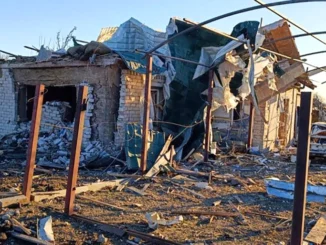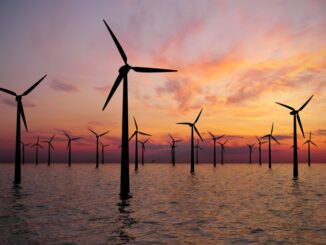
Like much of Europe, New England is transforming its electric grid, retiring coal, oil and nuclear plants, leaving it largely dependent on natural gas to keep the lights on and power its homes.
And, like much of Europe, New England could be on track for an expensive winter.
Despite New England’s goal of limiting carbon emissions, more than half of its electric power still comes from natural gas that comes into the region in pipelines and, exclusively unlike anywhere else in the United States, imported in liquefied form from overseas. The region’s squeeze between a fossil-fuel-reliant present and renewable-energy future always tightens when demand for home heating rises, but this year, the pressure could be significantly higher, as conflict with Russia has increased the cost of natural gas around the globe.
New England could be a mild, U.S.-based case of how much of the world, whether cut off from sufficient gas involuntarily or by choice, deals with the challenges of building out renewable energy resources while still relying on energy that comes out of the ground, as opposed to the wind and the sun.
Why New England?
New England’s challenges are most acute in the winter, when the need for electricity and heat strain its limited gas resources. In a typical winter, the region should be able to keep the gas flowing to homes without compromising the availability of electricity. But in the event of an extended cold snap, then there could be issues with electric reliability, the region’s grid operator, ISO-NE, said in a letter to Secretary of Energy Jennifer Granholm.
“The region is highly dependent on natural gas for both heating homes, which is a huge need for New England in the winter, and generating electricity,” said Caitlin Marquis, a director at Advanced Energy Economy. “If you have a very cold day, or if you have any extended cold stretch of days, you have an issue of not having enough fuel to meet combined heating and electricity needs of the region. There is limited infrastructure, and [there’s] not been much investment in supply infrastructure for a while.”
“We’re going into this winter basically crossing our fingers and hoping,” said one Federal Energy Regulatory Commission official at a recent forum it hosted.
Just over half of the electricity produced in New England comes from gas, which is largely imported through a network of pipelines that were largely laid down decades ago. The remaining balance of gas is imported, oddly enough, from overseas.
And while there has been more investment in renewable energy in New England — with huge planned investments, especially in wind power — it still relies on immediately available natural gas. In fact, by far the biggest shift in New England’s grid has been its increased use of gas, which now makes up three times as much of its energy usage than it did in 2000, while renewables have gone from 8 percent of electricity production to 12 percent. “In simple terms, renewables will displace fossil fuels, but the need for balancing energy (and in particular the long duration, peaking requirement for balancing energy) will increase,” ISO-NE said in its statement. “For the clean energy transition to be successful, the region must continue to have reliable supplies of gas for home heating and electricity.”
And New England still hasn’t kicked more carbon-intensive forms of power entirely.
While the region has retired thousands of megawatts worth of coal, plus nuclear and oil plants, sometimes when electricity needs spike, oil-burning power plants are turned on to keep the lights on, employing a form of generation that has largely disappeared from much of the country’s grid.
There are plans for more renewable energy, but, as Stephen George, an official at ISO-NE, said in a presentation, “Generator retirements occur on schedule, but new resources are often delayed.”
While New England’s electricity is less carbon-intensive than much of the country’s, its residents also pay some of the highest rates in the country.
New England is not the only region to be caught between its renewable energy future and its existing suite of energy resources, including fossil fuels and nuclear power. To address stress in its electricity system, California reversed itself on keeping open its sole remaining nuclear power plant, installed new gas-fueled power plants operated by the state itself, temporarily waived regulations on generators, along with continuing to expand its renewable power generation, installing batteries to store power, and enlisting the public and businesses to use less electricity at particularly high-usage times.
While the goals of these two regions, which are both wealthy and committed to aggressive climate goals, are to minimize the use of carbon-emitting sources of power, the demands of harsh weather and reliability have extended natural gas’s reign.
But the way New England maintains its reliance on gas makes it an outlier in the U.S. energy system. The country as a whole has reached rough energy self-sufficiency and, thanks to massive investments in building infrastructure to ship liquefied natural gas (LNG) literally overseas, has become a major gas exporter — one that the rest of the world is increasingly reliant on to deliver the gas that Russia no longer can or longer provide. Much of the gas that has turned the country into an energy-producing powerhouse is extracted not far from New England in Pennsylvania. But today, New England’s gas pipelines run from the Canadian border and even Texas and Louisiana.
That’s thanks to opposition both in New England itself and in neighboring states, especially New York, to building new pipelines.
New England vs. the world
While in the past six years, according to Energy Department data, the bulk of gas exports have gone to East Asia, in June the three largest export destinations were France, the Netherlands and Spain. In the past 12 months, the United States has exported 300 billion cubic feet of gas, while importing only 30 billion (not counting gas imports to Puerto Rico), the vast majority of which has gone through an import terminal in Everett, Massachusetts. New England’s gas imports are complicated by the fact that the shipments have to come from overseas, thanks to the Jones Act, which requires shipping that happens within the United States to occur on U.S.-flagged and U.S.-made craft, which the LNG industry does not use.
At the import terminals where LNG arrives in the Northeast, the average price for the gas is three times what it is at the export terminals largely on the Gulf Coast.
In effect, the rest of the country is sufficiently served with gas that can’t go anywhere else through the pipeline system, while New England has to go out on the global market to get the gas it needs to keep the lights on and homes warm. This is then reflected on electric bills, which are already high and starting to climb across the region.
“If we want a cargo full of LNG to come to Boston, we have to outcompete Europe,” said Meredith Angwin, an energy analyst and author of “Shorting the Grid.”
“New England is paying European prices for LNG,” Ira Joseph, an energy analyst, told Grid. “If there were a pipeline from Marcellus into New England, New England would be paying prices that were equivalent to the Marcellus Utica area plus transit, [but] that’s not the case.”
LNG can make up up to a third of the region’s whole natural gas supply, according to the Energy Information Administration. New England pays for the privilege, with prices for natural gas sometimes being five times higher in New England than the U.S. reference price in Louisiana.
“Even with the successful development of extensive offshore and onshore wind as well as solar generation in New England, the region will continue to be dependent on resources with the operating flexibility to balance and backstop this variable renewable generation to sustain reliability. Today, natural gas generation provides this flexibility, and in the future, this could include non-carbon-emitting energy storage technologies,” ISO-NE said in the Granholm letter.
The catch
Like Europe, when New England doesn’t have enough gas to both provide electricity and heat homes, it often turns to more polluting and carbon-intensive forms of power, including oil, to produce electricity. This past winter, New England burned the most oil it had in a decade in order to generate electricity.
For environmentalists and advocates for green energy, the current situation is not an indictment of their effort to limit or prevent new fossil fuel infrastructure, but proof that New England needs to redouble its efforts to generate and store energy renewably.
“We have the system we have, and we need to manage through the upcoming winter with resources we have. We can’t lose sight of longer-term needs to transition to natural gas to more renewables, energy storage, building out transmission infrastructure to get us away from this annual cycle of worrying about the upcoming winter and how we’re going to manage through,” Marquis said.
A coalition of environmental groups pointed to Texas’ winter storm Uri, where the state was hammered by devastating blackouts due, in part, to unavailability of natural gas, as a sign that gas is not always as available as it’s marketed to be.
“The solution is not to put good money after bad by building more fossil fuel generation or costly pipelines that will never pay off, but instead to invest in clean solutions that will make the region’s electric system more reliable while reducing the emissions causing climate change,” the coalition of groups said.
For them, the response to New England’s electricity woes should be to invest more in demand-response and demand-management systems in the short term, which can reduce the amount of electricity needed from the grid at times of high usage, while investing in new renewable energy and storage capacities to eventually replace much of the role gas currently plays.
“If they’re called upon to reduce their demand immediately,” June Tierney, a Vermont energy official said, “they will respond.”
In any case, New England may face a mild or even average winter and make it through. But the problem of adequacy will likely persist.
“Until the Ukraine War, most articles about the grid were about the grid we could have,” Angwin said, “People don’t know what the constraints are on the grid we do have, people are waking up now.”



